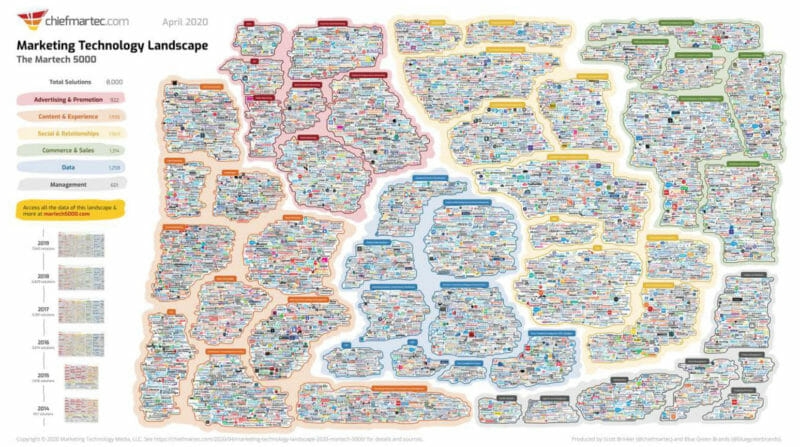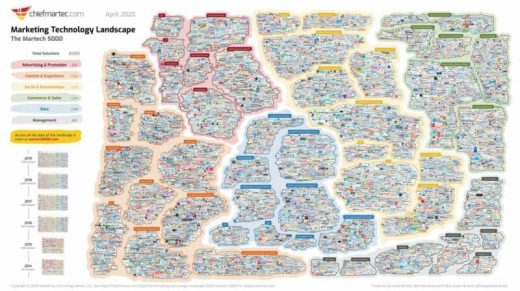Before you rip and replace another martech tool, it may be time to build a roadmap
More than 80% of marketing technologists reported they had upgraded at least one marketing tech application last year, according to MarTech Today’s 2020 MarTech Replacement Survey.

This year, the Marketing Technology Landscape reached a whopping 8,000 martech tools. With so many available solutions, it’s no wonder martech leaders have a difficult time reining in the number of solutions they implement.
“We see customer tech stacks that have 30-plus applications — even 50-plus is not unusual,” said Ed King, CEO for the data orchestration platform Openprise, “Installation for a lot of these marketing technologies and sales technologies are very easy. This is the attraction of [the tools], but making them work together is becoming more like a nightmare.”
During his Discover MarTech presentation, King outlined the challenges marketing technologists face in terms of building a scalable and manageable martech stack — and offered a roadmap for organizations to move their “martech maturity” to the next level.
Martech has reached a crossroads
King says the martech industry is at a crossroads where things are getting way too complex, with many marketing technologists trying to solve issues by adding more middleware. It’s a logical reaction, according to King, but only works if the technologist knows what they’re doing.
“The problem is most marketing operations and sales operations professionals don’t have the proper integration skill set and background,” said King. More often than not, marketing technologists end up adding more pieces of middleware, or integration in the the middle, which only makes things more complex.
“When you try to install new technology to solve a problem, you may actually end up creating additional problems,” said King.
According to our own 2020 MarTech Replacement Survey, MarTech Today found 83% of the nearly 400 marketing technologists we surveyed had upgraded or replaced a martech tool in the past year. Nearly half reported they had switched from an in-house tool to a commercial SaaS product.
“We really need to have a more methodical approach to look at how we deal with — or even refactor — our tech stack,” said King.
Assessing your martech needs
According to King, a martech stack includes six functional areas: data gathering and storage, data quality, funnel management, process automation, reporting and analytics, and compliance. To be effective within these six areas, King ascribes a maturity model for each, with five different levels of maturity — ranging from the “just getting started stage” where tools are implemented in an ad hock manner to level five where systems are well-oiled, integrated platforms designed to drive business outcomes.
In order gauge your maturity level for each of the six areas, martech teams must commit to an assessment — either internally or conducted by an outside consultancy — to discover where there are gaps in the technology stack and where tools overlap. According to a King, an effective assessment will help evaluate and justify new technology investments, as well as determine if existing martech contracts should be renewed.
“Once you have done an assessment — and picked the areas where you need to focus — the next thing is to start building your roadmap,” said King.
People come first
When building out your martech stack roadmap, King says to focus on people, process, data and technology — in that order. Often times, martech leaders want to jump straight to the technology, thinking that the right technology will get them to where they want to go. But, the technology doesn’t matter if you don’t have the right people in place to run it and effective processes to manage it.
“If you have people who don’t know what they’re supposed to do — if you have a process that’s deficient or broken and you don’t have the right data, your technology will not work,” said King.
He also recommends keeping the length to time it takes to roll-out a martech stack project plan as short as possible — in King’s experience, anything that takes longer than three months to complete rarely gets done. A longer plan usually means there’s room to scope it into smaller, more bite-sized type projects, implementing a more agile incremental approach to building the stack.
King advises against a “Field of Dreams” approach — the “if you build it, they will come” theory.
“A lot of CDP projects tend to follow this type of approach — just build this 360-degree view of the customer and the business guys will figure out what to do with it,” said King, “Instead of trying to build something that is an idealistically utopian pathway, maniacally focus on who are my target users, my target customers, and why are we doing this.”
Marketing Land – Internet Marketing News, Strategies & Tips
(18)



